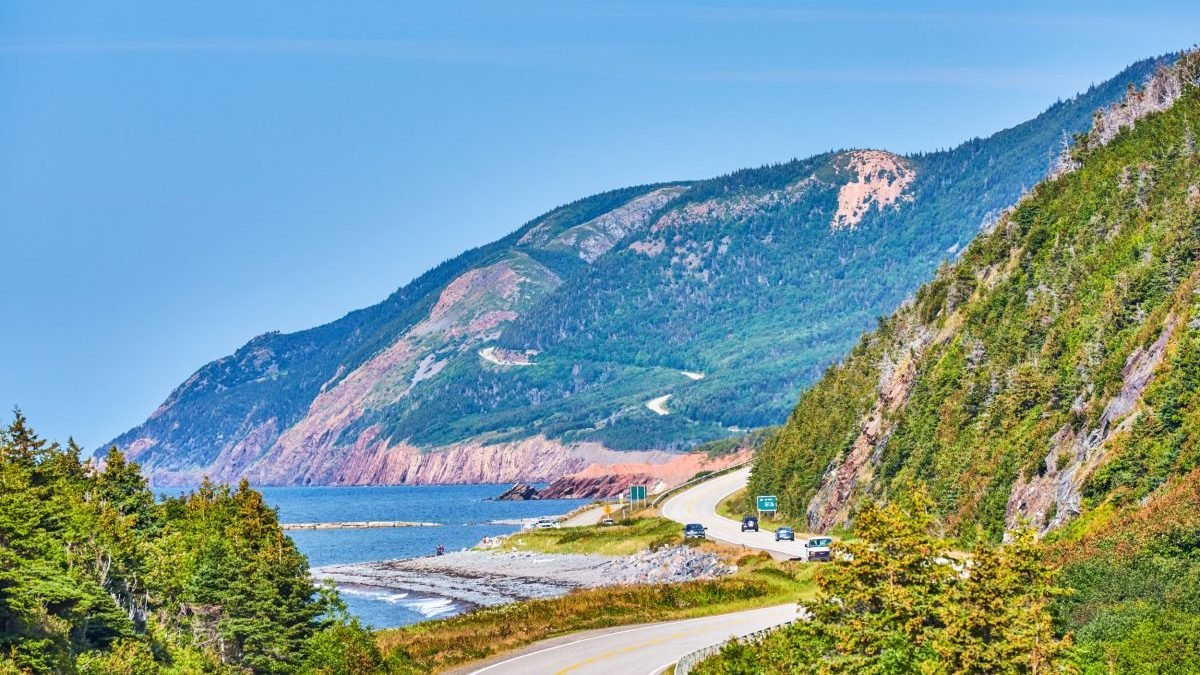Travel Journals
How Long Should It Take To Get From Chicago to Minnesota?

A Tesla driver shared what road tripping in an EV entails: A lot of charging stops. At least, if you did it the way she did, and there are ways to avoid the same pitfalls.
Social media user Meryl (@maybe.meryl) recorded snippets of her journey in a clip that she posted on the widely used social media app. Although she clearly shows she needed to charge up five separate times on her journey, several people replied that she should’ve been able to complete her travel itinerary sooner.
Meryl begins her video seated inside of a Tesla. Her camera’s lens is directed at the large infotainment screen that’s become synonymous with the electric-vehicle maker. A large map indicates that she’s beginning her journey in Minneapolis, and she has one hour and eight minutes to go before she hits her first Tesla Supercharger.
The route indicates that after this first charge, she needs to make at least three more stops before she reaches her Chicago destination.
Tesla Road Trip Charging
From the get-go, she intimates that this long drive isn’t going to be a pleasant one. “The reality of road tripping in an EV,” she pens, capping off her commentary with a skull emoji. After this initial shot, she records herself driving on a highway in her Tesla. Afterward, she records herself plugging a Tesla Supercharger plug into her charging port.
Then, her video transitions to her on the highway again, traveling at 74 mph. The next Supercharger spot she arrives at is her third. An on-screen caption reveals that she “forgot to record no. 2” as she pulls up to the charging stations. Several of them are open with a white Model 3 seen charging at one of the stalls. Additionally, there seems to be a Volvo C40 utilizing a Tesla charging stall as well.
Volvo joins a long list of EV manufacturers that can benefit from Tesla’s massive Supercharger network, which means that folks who need to top off in a jiffy have more options than ever available to them. That is, as long as folks have the necessary adapter on hand to use Tesla’s charger network.
Even More Supercharger Stops
Meryl records herself juicing up yet again before she’s back on the road, this time at a speedier 80 miles per hour. The sun has gotten visibly lower at this point in her journey. And as she arrives at her fourth supercharger, the amber glow of dusk hangs in the clouds. At the Supercharger station closest to her destination, there’s only a single vehicle juicing up, which looks like a Rivian. Again, Meryl plugs in her car and when she’s driving again, night still hasn’t set.
But it seems that she’s still not done charging her car, either. Because she has to juice up her Tesla yet again, plugging it in for the fifth time on her journey. At the end of her video, she records herself finally making it to Chicago. A text overlay in her clip reveals the total amount of time it took her to get there in an EV. “Made it from MN to Chicago in 7 hours,” she writes. Meryl punctuates her feelings about the total travel time with a crying emoji as her clip comes to an end.
Furthermore, a caption for her clip speaks to a problem many EV owners have opined about with regards to range estimate inaccuracies. She wrote: “I had to stop every 70 miles, I swear.”
For comparison, Google Maps projects that folks driving in a traditional, internal combustion engine vehicle from Minneapolis to Chicago, while maintaining the legal speed limit should make the 408-mile trip in 5 hours and 52 minutes.
So is she correct here? There are habits to employ in your next EV road-trip to avoid this conundrum.
Commenters Sound Off
One user who replied to Meryl’s video criticized her approach to charging her vehicle.
They said that since she began her journey with a 30% charge on her EV, she was already beginning her trip with a mostly depleted battery. Furthermore, they also critiqued her for driving faster than the speed limit, which will decrease a battery’s charge more quickly than it would at slower speeds.
Despite seeing her clip, which features multiple charging stops, they speculated that she would’ve had to have only stopped once during her journey.
“Started at 30% battery. Didn’t charge to 80% at any one stop. ~400 miles, you should have only had to stop once for a charge. Also, isn’t the top speed between Minneapolis and Chicago [is] 70, not 85,” they said.
However, Meryl, having made the drive herself, countered their points. First, she explained that she was “speeding up to pass” another car in the snippet that she shared. Additionally, she stated that despite charging her battery to 80%, her Tesla’s navigation application indicated that she’d have a significantly lowered charge after 130 miles of driving. In fact, it’d be in the negative. “I tried mapping directly when there were only 130 [miles] left and it said I would arrive with -23% from 80%.”
EV Road Trips
While there are plenty of EVs that have managed to travel impressive distances on a single charge, many consumer vehicles fall short of their EPA range estimates. Teslas aren’t excluded from this criticism, either.
The discrepancy between real-world and actual range has left some Tesla buyers questioning the travel capacity of their cars, like a Tesla Motors Club driver who saw their maximum Model Y range, even at full capacity, was less than its quoted 303 mile mark. One user attributed the shortcoming to battery degradation. However, there are other Tesla owners who had such mitigated range that they thought their cars were defective. As Ars Technica writes: “Tesla exaggerated EV range so much that drivers thought cars were broken.”
This isn’t the case for all electric vehicles, however. InsideEVs compiled a list of fully-electric cars assessed by Consumer Reports that actually performed better than their quoted EPA estimates. The BMW iX managed to eke out 61 more miles of driving past its 309 quoted range. The Mercedes-Benz EQS 580 sedan managed to travel 380 miles on just a single charge. Other offerings from BMW, the i4 and i5 also went further than their quoted EPA ranges. And the Hyundai Ioniq N was able to travel 15 miles longer than its advertised range.
Ultimately, an EV road trip depends on good driving habits—including slowing down when appropriate—planning ahead using apps like PlugShare or the car’s onboard route-planner system, and a bit more patience. But more and more, this kind of experience is an outlier rather than the norm.
InsideEVs has reached out to Meryl via email for further comment.
Travel Journals
A road trip on Ireland’s rugged northern coast, where the food is as good as the views

House martins and swallows are our constant companions, whether snapping up fluttering mayflies in the car park of Glencar Waterfall during a downpour or swooping from the eaves of The Shandon Hotel that overlooks Marble Hill Strand beach in Donegal, where linen-coloured sand slips into grey-green ocean.
It might only have celebrated its 10th official birthday in 2024 but Ireland’s 2,500km (1,550-mile) Wild Atlantic Highway has been used by generations of these nippy little migratory birds, who fly from the Sahara to spend their summers in the UK and Ireland.
The clever things know about Northern Ireland’s Causeway Coastal Route too.
Aside from the 60-million-year-old natural geometrical marvel that is Giant’s Causeway, this 193km stretch of raggedy, bewitching coastline, which starts in Belfast and ends in Derry, often gets lopped off road trips. But no more.
As part of the Shared Island initiative, which “aims to harness the full potential of the Good Friday Agreement to enhance cooperation, connection and mutual understanding on the island”, Tourism Northern Ireland and Fáilte Ireland have teamed up to remind visitors that once you hit the end of the Wild Atlantic Way, the sea has not run its course, the cliffs do not peter out and the Guinness really does not dry up.
Travel Journals
The laid-back ocean playground with coastal road trips and fresh shellfish

Less than a seven-hour flight from the UK, this maritime province in Atlantic Canada makes for a refreshing summer road trip
I love the office view I have,” said Kinnon, smiling beneath his baseball cap as he squished in beside me to guide his rigid inflatable boat out of Ingonish Harbour and into the chilly waters off Nova Scotia.
It was definitely better than my office view in London on a glorious June day in eastern Canada. A majestic sea eagle wheeled above our heads, a puffin bobbed about beside the boat and – in the distance – sleek gannets plunged down in search of fish.
Lobster fishermen methodically pulled up pots, an action repeated up to 275 times a day during their short season. I watched one crew take seven of the crustaceans from a single pot, throwing back another 13 that were too small or carrying eggs.
Looming behind them were the pine-covered cliffs of a finger-like peninsula that juts out between two sweeping bays, where the previous day we had hiked a woodland trail.
Now we were searching for whales. “Can you smell that: stinky minke?” asked Kinnon as a stench like rotting fish and cabbage wafted over the water.
Grey backs arced through the waves to gasps of delight from my fellow passengers. The mammals disappeared into the deep, before popping back up in different places around our little boat.
Kinnon told us about spotting killer whales. “I love seeing them. But they eat these guys, so I’m a bit torn over their appearances.”
We saw a few more minke before powering back to the harbour. My wife and I had chosen Nova Scotia for a road trip on something of a whim, lured by its relative proximity to the UK, compared with most of North America (a less than seven-hour flight) and its Celtic heritage. It has the largest Gaelic-speaking community outside Scotland.
Our trip began in Halifax, the province’s fast-growing – but chilled out – capital. Its bustling boardwalk, stretching almost three miles along the city’s waterfront, is studded with bars, restaurants and ice-cream parlours.
The Maritime Museum of the Atlantic grabs attention with its Titanic artefacts – reflecting how 150 of the victims recovered from the disaster were laid to rest in three of the city’s cemeteries.
Yet I found myself unexpectedly moved at the other end of the boardwalk, by the Canadian Museum of Immigration.
It is located at Pier 21, where more than 1.5 million people landed during the past century in search of new lives. The exhibits gave a glimpse into the huge challenges – and discrimination, at times – facing the waves of refugees, orphans and war brides flowing through.
The impact was underlined by handwritten notes from visitors. One woman stated she was there on her 50th birthday to honour her Italian father, adding that he never forgot his life-changing journey and would proudly tell her of his arrival at Pier 21.
Canada’s modern role as a nation built on migration was underlined. “I thank my parents for their love and sacrifices for me,” wrote one Asian man. “Also Canadians for their welcoming generosity.”
A Ukrainian family who arrived two years ago thanked Halifax for embracing them with its “ocean life” and “green lawns”, declaring that the region “took our hearts” by reminding them of the Black Sea and Carpathian mountains they fled due to war.
Nova Scotia has 8,300 miles of coastline and you’re never more than 50 miles from the sea, so this is a land of lighthouses and seafood. As we headed north to Advocate Harbour, we found its roads to be uncrowded (and Canadians must be among the planet’s politest drivers).
This drive took us past the Bay of Fundy, with tidal bore rafting that is like a muddy and wet rollercoaster, and weird “Flower Pot Rocks” – pillars of sandstone carved by fiercely-churning tides, topped with clumps of trees.
We stayed at Wild Caraway, a restaurant with rooms run by a friendly young couple called Andrew and Fiona. The vibe was informal. But the food, often foraged locally, was inventive: fiddleheads – furled fronds of ferns – with balsam fir and lemon were followed by halibut and asparagus in chive sauce.
A superb breakfast, delivered to our cabin, needed to be walked off on nearby beaches fringed with driftwood and devoid of people. Later, a “seacuterie” platter arrived with potted prawns and rollmop herring, which we washed down with beers sitting by the fire pit in the yard as dusk descended.
We drove hundreds of miles, snaking through a forested wilderness landscape filled with bears, moose and raccoons in this underpopulated slice of Canada that sits on similar latitude to southern France (and Nova Scotia can also boast of producing some fine wines).
We took a detour to Arisaig – a lobster port named after the Scottish highland village that neighbours my wife’s home town of Mallaig.
The Cabot Trail – a highway loop around Cape Breton, famed for its hilly twists and steep turns – was gentler than anticipated, despite often-impressive views.
Chéticamp was a fun stop with its folk-art feel and French speakers, a reminder of how the French and English tussled over Nova Scotia for more than a century on terrain originally inhabited by the Mi’kmaq people.
I feared the historic port of Lunenburg, a World Heritage Site, might be a tourist trap – but it turned out to be delightful.
Finally, we drove back to Halifax for a blowout at Drift, a striking harbour-side restaurant, before bedding down in the casual luxury of the Muir Hotel ahead of our hop home over swirling Atlantic seas that define this laid-back corner of Canada.
Getting there
Air Canada flies to Halifax from Heathrow, while WestJet flies from Edinburgh.Staying there
The Muir Hotel in Halifax has doubles from C$600/£329 per night.Wild Caraway Restaurant & Rooms, Advocate Harbour, has doubles from C$188/£103 and cottages from C$313/£171.
More information
The writer travelled as a guest of Tourism Nova Scotia.
canada.ca/en
Travel Journals
Columbia River Swim Spots and Beaches Under 90 Minutes from Portland

Windsurfers can catch some air at Doug’s Beach State Park, just east of Lyle, Washington.
The Pacific is cold, the Sandy River is mobbed, local public pools have limited hours and long lines, and your secret mountain swimming hole is either not so secret anymore or still inaccessible after the fires of recent years. The giant Columbia River is here for you. Sure, I-84 and train tracks can complicate access. Industrial neighbors, container ships, and barges aren’t always the backdrop of your summer beach dreams. But you can find water lapping on sand or stones at many spots along the river’s run, from where it meets the Pacific all the way through the Columbia River Gorge and farther inland.
Here are some spots within an hour and a half of Portland, organized by river mile: Mile 0 is where the Columbia meets the Pacific Ocean at Cape Disappointment, and river mile 101 is where the Willamette joins the Columbia.
In some places, currents, debris, and nearby industrial activity or boat launches make swimming or even wading unwise. Always obey posted signs, and use the river at your own risk.
Looking west at Jones Beach, near Clatskanie.
Jones Beach
River mile: 46
Closest town: Clatskanie, Oregon
Travel time from downtown: 1 hour, 25 minutes
Wave to the cows, horses, and deer on your way to this windswept expanse of sand popular with fishers. Bring a picnic blanket—the few picnic tables here look like they might have come from the set of The Road Warrior, as does the askew sign letting visitors know that ATVs are not allowed. —Margaret Seiler
Along the road at Dibblee Beach.
Dibblee Beach
River mile: 65
Closest town: Rainier, Oregon
Travel time from downtown: 1 hour, 5 minutes
Most of the signs at this Columbia County park aren’t about water safety or park etiquette—instead, they threaten huge fines for neglecting to pay the day-use parking fee. (OK, we get it!) That dubious welcome aside, this lengthy stretch of sand just west of downtown Rainier is, like Jones, popular with fishers. —MS
Fishing at Prescott Beach.
Prescott Beach
River mile: 71
Closest town: Prescott, Oregon
Travel time from downtown: 1 hour
The Columbia County park day use fee is required here, too, but you won’t find all the menacing signs like at Dibblee. You will find scattered benches, picnic tables, and fire rings/grills. There’s a designated fishing area, and you’ll want to bring a designated driver so you can stop at the storied Goble Tavern on your way home. —MS
A front-row seat to industrial activity at Trestle Beach.
Trestle Beach
River mile: 83
Closest town: Columbia City, Oregon
Travel time from downtown: 45 minutes
Not the most peaceful spot thanks to the Knife River facility dropping sand and other materials onto barges right in front of the beach, but still a sandy strand lined with trees and popular with dog owners and fishers. The gate to the parking area is locked promptly at the posted time (generally 5pm, but it changes to 7pm in the summer), so don’t get stuck. —MS
Tiny Columbia City is home to the even tinier Pixie Park.
Pixie Park
River mile: 84
Closest town: Columbia City, Oregon
Travel time from downtown: 45 minutes
You might think this park, on property owned by the Daughters of the American Revolution, was so named because it’s just so darn adorable, but it actually owes its moniker to a boat known as the Pixie. The Caples House Museum is nearby. —MS
Reeder Beach, one of Sauvie Island’s five beaches.
Sauvie Island
River mile: 94
Closest town: Portland, Oregon
Travel time from downtown: 35 minutes
Sauvie Island is technically home to five beaches—Reeder, North Unit, Walton, Collins, and Warrior Point. One of the more popular of the five, Walton is a solid all-around family beach, and on hot days it can be hard to get a parking spot nearby. (Make sure to pick up a parking pass, required in all wildlife areas on Sauvie Island. As of 2025, weekends and holidays through Labor Day also require a free beach pass, which can be booked online two weeks in advance.) The beach offers soft sand, temperate water, and a picturesque view straight across to Washington. If you can handle a little nudity, the clothing-optional Collins Beach boasts clearer water and fewer crowds. —Katherine Chew Hamilton
Kelley Point: better for a picnic than a swim.
Kelley Point Park
River mile: 102
Closest town: Portland, Oregon
Travel time from downtown: 20 minutes
Kelley Point is a beautiful place to ride your bike, sit on a log, have a picnic, and watch the ships go by, as the City of Portland technically prohibits park users from swimming or entering the water here due to “unsafe and unpredictable conditions.” Several people have drowned at the park, including two within one week in 2016, because of the high currents where the Willamette and Columbia meet. Given the number of trash barges we’ve seen floating along, staying out of the water sounds OK to us. —KCH
Wintler Community Park
River mile: 110
Closest town: Vancouver, Washington
Travel time from downtown: 18 minutes
This eastern terminus of the five-mile Columbia River Renaissance Trail from downtown Vancouver offers restrooms, picnic tables, a steep sandy beach, and a view of the action at PDX airport across the river. There’s a parking fee required from May 1 to September 30. —MS
Broughton Beach
River mile: 110
Closest town: Portland, Oregon
Travel time from downtown: 18 minutes
By Salty’s, the Sextant, and the airport, this Metro-managed beach always has something odd happening: an unexplained intact melon just sitting there, a man with a guitar sitting alone on the hood of his car playing a song you swear you heard in a dream. Oh, and there’s a giant, windswept sandy beach with room for you, me, and everyone we know. Metro requires a day-use parking fee, and if you get hooked on the bike path that runs along Marine Drive you might want to invest in the annual pass. (The pass also works at Metro’s Chinook Landing Marine Park, about nine miles east of Broughton, but that park is primarily a boat launch site and not really a beach. Chinook Landing has an archery range, too.) —MS
One of the spots at Cottonwood Beach is lined with several grounded historical boats.
Cottonwood Beach
River mile: 123
Closest town: Washougal, Washington
Travel time from downtown: 30 minutes
One of the Lewis-and-Clarkier spots on this list, Cottonwood Beach has plenty of interpretive signs about the Corps of Discovery’s stop here and the Indigenous groups that long called the area home, along with several historical watercraft. Get there early on a summer day to claim one of the little private patches of sand down the hill from nicely distanced picnic tables. Multiple signs remind visitors that there’s no alcohol allowed (with an added sign proclaiming “NO TOLERANCE” in case it was unclear), so make a post-beach stop at the 54˚40″ brewery taproom for a Half Cocked IPA and perhaps some pizza. —MS
Clothes or no clothes? The choice is yours at Rooster Rock.
Rooster Rock State Park
River mile: 129
Closest town: Oregon
Travel time from downtown: 30 minutes
Rooster Rock, divided into family-friendly and clothing-optional areas, is far enough away to feel like an escape from the city while easily fitting into a half-day trip. When temperatures rise, people cram onto a small sandy peninsula, beer cans crack open, Bluetooth speakers blast reggaeton, and you might catch people floating by on swan-shaped inflatables. The clothing-optional area brings its own party vibe. There are restrooms and picnic tables for enjoying a feast with a view of the water—note that if you’re planning on bringing a cooler to the sandy beach, you’re in for a bit of a walk. The water may have its fair share of floating debris, but the picturesque scenery and carefree vibes make up for it. —KCH
Viento State Park
River mile: 161
Closest town: Oregon
Travel time from downtown: 1 hour
Dodge some of the Hood River crowds and score some shade by taking a dip a few miles west of town at Viento State Park, also popular with windsurfers (viento means wind, after all), where you can also camp—the tent sites up the hill are farther from the water but are a bit calmer than the ones you’ll find between the railroad tracks and I-84. —MS
If the beach gets boring, there’s a climbing wall and playground just steps away at Hood River Waterfront Park.
Hood River Waterfront Park
River mile: 169
Closest town: Hood River, Oregon
Travel time from downtown: 1 hour, 10 minutes
This plush spot offers a roped-in section for swimming, a sandy crescent for sunbathing, a bird’s-eye view on the kiteboarders and windsurfers weaving their way across the river, clean restrooms, and a notch-above-the-ordinary playground with a rock climbing wall. No need to pack a picnic, either—you can easily walk to any of several great lunch spots, including Pfriem Family Brewers, Solstice Wood-Fire Pizza, or Ferment Brewing Company. —Julia Silverman
Blooms on the beach at Mayer State Park.
Mayer State Park
River mile: 181
Closest town: Mosier, Oregon
Travel time from downtown: 1 hour, 20 minutes
While this area is better known for the Gorge views offered uphill at the Rowena Crest Overlook, down at river level Mayer State Park provides a rocky beach and duck-packed coves to explore, plus a boat launch and lifejackets to borrow. A day-use fee (or an annual state parks pass) is required to park. —MS
Splashing around at Doug’s Beach, on a rare day with no windsurfers.
Doug’s Beach
River mile: 184
Closest town: Lyle, Washington
Travel time from downtown: 1 hour, 25 minutes
Just east of Lyle, Washington, Doug’s Beach State Park offers a shaded beach and picnic tables. You’ll need a Discover Pass to park here along SR-14 (the lot is well patrolled, so don’t risk going without), and be very careful crossing the tracks. —MS
-

 Brand Stories2 weeks ago
Brand Stories2 weeks agoBloom Hotels: A Modern Vision of Hospitality Redefining Travel
-

 Brand Stories2 weeks ago
Brand Stories2 weeks agoCheQin.ai sets a new standard for hotel booking with its AI capabilities: empowering travellers to bargain, choose the best, and book with clarity.
-

 Destinations & Things To Do2 weeks ago
Destinations & Things To Do2 weeks agoUntouched Destinations: Stunning Hidden Gems You Must Visit
-

 Destinations & Things To Do2 weeks ago
Destinations & Things To Do2 weeks agoThis Hidden Beach in India Glows at Night-But Only in One Secret Season
-

 AI in Travel2 weeks ago
AI in Travel2 weeks agoAI Travel Revolution: Must-Have Guide to the Best Experience
-

 Brand Stories1 month ago
Brand Stories1 month agoVoice AI Startup ElevenLabs Plans to Add Hubs Around the World
-

 Brand Stories4 weeks ago
Brand Stories4 weeks agoHow Elon Musk’s rogue Grok chatbot became a cautionary AI tale
-

 Brand Stories2 weeks ago
Brand Stories2 weeks agoContactless Hospitality: Why Remote Management Technology Is Key to Seamless Guest Experiences
-

 Asia Travel Pulse1 month ago
Asia Travel Pulse1 month agoLooking For Adventure In Asia? Here Are 7 Epic Destinations You Need To Experience At Least Once – Zee News
-

 AI in Travel1 month ago
AI in Travel1 month ago‘Will AI take my job?’ A trip to a Beijing fortune-telling bar to see what lies ahead | China













You must be logged in to post a comment Login